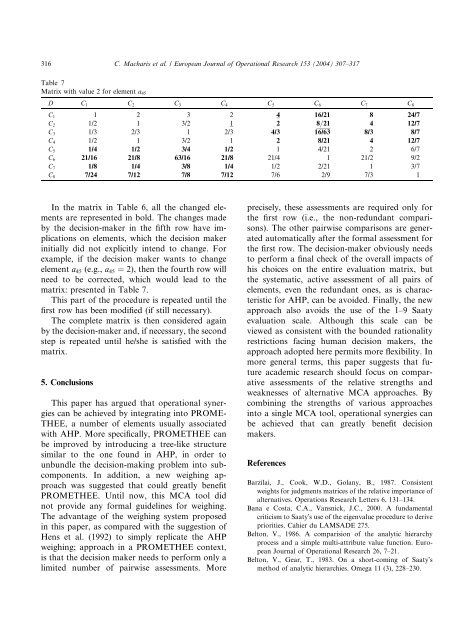PROMETHEE and AHP: The design of operational synergies in ...
PROMETHEE and AHP: The design of operational synergies in ...
PROMETHEE and AHP: The design of operational synergies in ...
Create successful ePaper yourself
Turn your PDF publications into a flip-book with our unique Google optimized e-Paper software.
316 C. Macharis et al. / European Journal <strong>of</strong> Operational Research 153 (2004) 307–317<br />
Table 7<br />
Matrix with value 2 for element a45<br />
D C1 C2 C3 C4 C5 C6 C7 C8<br />
C1 1 2 3 2 4 16/21 8 24/7<br />
C2 1/2 1 3/2 1 2 8=21 4 12/7<br />
C3 1/3 2/3 1 2/3 4/3 16/63 8/3 8/7<br />
C4 1/2 1 3/2 1 2 8/21 4 12/7<br />
C5 1/4 1/2 3/4 1/2 1 4/21 2 6/7<br />
C6 21/16 21/8 63/16 21/8 21/4 1 21/2 9/2<br />
C7 1/8 1/4 3/8 1/4 1/2 2/21 1 3/7<br />
C8 7/24 7/12 7/8 7/12 7/6 2/9 7/3 1<br />
In the matrix <strong>in</strong> Table 6,all the changed elements<br />
are represented <strong>in</strong> bold. <strong>The</strong> changes made<br />
by the decision-maker <strong>in</strong> the fifth row have implications<br />
on elements,which the decision maker<br />
<strong>in</strong>itially did not explicitly <strong>in</strong>tend to change. For<br />
example,if the decision maker wants to change<br />
element a45 (e.g., a45 ¼ 2),then the fourth row will<br />
need to be corrected,which would lead to the<br />
matrix: presented <strong>in</strong> Table 7.<br />
This part <strong>of</strong> the procedure is repeated until the<br />
first row has been modified (if still necessary).<br />
<strong>The</strong> complete matrix is then considered aga<strong>in</strong><br />
by the decision-maker <strong>and</strong>,if necessary,the second<br />
step is repeated until he/she is satisfied with the<br />
matrix.<br />
5. Conclusions<br />
This paper has argued that <strong>operational</strong> <strong>synergies</strong><br />
can be achieved by <strong>in</strong>tegrat<strong>in</strong>g <strong>in</strong>to PROME-<br />
THEE,a number <strong>of</strong> elements usually associated<br />
with <strong>AHP</strong>. More specifically,<strong>PROMETHEE</strong> can<br />
be improved by <strong>in</strong>troduc<strong>in</strong>g a tree-like structure<br />
similar to the one found <strong>in</strong> <strong>AHP</strong>,<strong>in</strong> order to<br />
unbundle the decision-mak<strong>in</strong>g problem <strong>in</strong>to subcomponents.<br />
In addition,a new weigh<strong>in</strong>g approach<br />
was suggested that could greatly benefit<br />
<strong>PROMETHEE</strong>. Until now,this MCA tool did<br />
not provide any formal guidel<strong>in</strong>es for weigh<strong>in</strong>g.<br />
<strong>The</strong> advantage <strong>of</strong> the weigh<strong>in</strong>g system proposed<br />
<strong>in</strong> this paper,as compared with the suggestion <strong>of</strong><br />
Hens et al. (1992) to simply replicate the <strong>AHP</strong><br />
weigh<strong>in</strong>g; approach <strong>in</strong> a <strong>PROMETHEE</strong> context,<br />
is that the decision maker needs to perform only a<br />
limited number <strong>of</strong> pairwise assessments. More<br />
precisely,these assessments are required only for<br />
the first row (i.e.,the non-redundant comparisons).<br />
<strong>The</strong> other pairwise comparisons are generated<br />
automatically after the formal assessment for<br />
the first row. <strong>The</strong> decision-maker obviously needs<br />
to perform a f<strong>in</strong>al check <strong>of</strong> the overall impacts <strong>of</strong><br />
his choices on the entire evaluation matrix,but<br />
the systematic,active assessment <strong>of</strong> all pairs <strong>of</strong><br />
elements,even the redundant ones,as is characteristic<br />
for <strong>AHP</strong>,can be avoided. F<strong>in</strong>ally,the new<br />
approach also avoids the use <strong>of</strong> the 1–9 Saaty<br />
evaluation scale. Although this scale can be<br />
viewed as consistent with the bounded rationality<br />
restrictions fac<strong>in</strong>g human decision makers,the<br />
approach adopted here permits more flexibility. In<br />
more general terms,this paper suggests that future<br />
academic research should focus on comparative<br />
assessments <strong>of</strong> the relative strengths <strong>and</strong><br />
weaknesses <strong>of</strong> alternative MCA approaches. By<br />
comb<strong>in</strong><strong>in</strong>g the strengths <strong>of</strong> various approaches<br />
<strong>in</strong>to a s<strong>in</strong>gle MCA tool,<strong>operational</strong> <strong>synergies</strong> can<br />
be achieved that can greatly benefit decision<br />
makers.<br />
References<br />
Barzilai,J.,Cook,W.D.,Golany,B.,1987. Consistent<br />
weights for judgments matrices <strong>of</strong> the relative importance <strong>of</strong><br />
alternatives. Operations Research Letters 6,131–134.<br />
Bana e Costa,C.A.,Vansnick,J.C.,2000. A fundamental<br />
criticism to SaatyÕs use <strong>of</strong> the eigenvalue procedure to derive<br />
priorities. Cahier du LAMSADE 275.<br />
Belton,V.,1986. A comparision <strong>of</strong> the analytic hierarchy<br />
process <strong>and</strong> a simple multi-attribute value function. European<br />
Journal <strong>of</strong> Operational Research 26,7–21.<br />
Belton,V.,Gear,T.,1983. On a short-com<strong>in</strong>g <strong>of</strong> SaatyÕs<br />
method <strong>of</strong> analytic hierarchies. Omega 11 (3),228–230.









